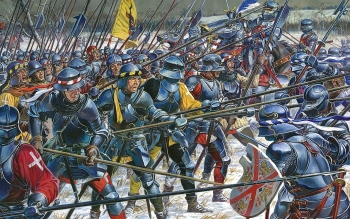One aspect of the military revolution which is alleged to have begun at the end of the fifteenth century is that infantry became more important in the field. This nearly contemporary picture of the battle of Nancy (1477) shows the power of Swiss infantry armed with pykes and halbards. Infantry armed with similar weapons were important in warfare as early as the twelfth century.
Even when mounted knights ruled European battlefields, foot soldiers undoubtedly outnumbered them, since each knight needed servants and supporters to keep himself, his horse, and his weapons in working order. But infantrymen whose role was to support (and mop up after) a cavalry charge remained subordinate. Warfare in western Europe began to alter when drilled infantry, whether independent or in rivalry with mounted knights, regained importance. This started as early as the twelfth century, when Italian townsmen managed to defeat an imperial army of German knights that recklessly charged the close-arrayed burghers’ pikes at Legnano in 1176. A bit more than a century later, Swiss infantry repelled the knights that their Hapsburg overlord sent to subdue them and soon established themselves as the most formidable pikemen of Europe. Oddly enough, in distant Japan pikemen also proved their usefulness against charging cavalry, beginning in the fourteenth century; while in the Middle East Ottoman foot soldiers, the famous janissaries, started winning victories for the sultans in the fifteenth century; and offensive deployment of infantry changed the Chinese way of war in the sixteenth. Except in Europe, pikemen succeeded in battle only in association with cavalry bowmen, who guarded the flanks, harassed the enemy with their missiles, and were ready to pursue the fleeing foe as soon as charging pikes broke up the opposing army. In Europe cavalry continued to prefer the lance; and light infantry equipped with crossbows (or in England with long bows) provided pikemen with long range missile support, while knightly cavalry defended flanks and rear.
Wherever massed pikemen began to take part in battle, we can assume that practice was needed to keep formation; marching in step was the obvious way to achieve that result.
The idea of a sixteenth-century ‘military revolution’ which transformed European warfare was formulated by Professor Michael Roberts in the mid-1950s. Historians have argued over the precise timespan of this revolution and some of its details, but the concept that such a revolution occurred has been widely accepted. By contrast, the preceding Middle Ages have been presented as an era when the practice of war was unprofessional and changed little. They have been characterized as ‘the long interregnum between the disappearance of the disciplined armies of Rome and the appearance of state forces in the sixteenth century’ (John Keegan, A History of Warfare). As this suggests, historians have seen the military revolution in the context of the growth of the modern state after a long period of stagnation following the collapse of the Roman Empire. However, while important changes did occur in war and military organization in the sixteenth and seventeenth centuries, it is arguable that their extent and novelty have been exaggerated.
According to Professor Roberts, the century after 1560 witnessed critical changes: a tactical revolution, in which musketeers in linear formations replaced lance and pike, and massed firepower ‘blew away’ feudal cavalry and blocks of pikemen; a massive growth in the size of European armies; and the adoption of more complex strategies to bring those armies into action. All these increased the burden of war on society, requiring the development of ‘modern’ states to recruit, pay for, and supply the new armies. Professor Geoffrey Parker’s influential revision of 1976 pushed the starting date of the transformation back to the late fifteenth century, as well as stressing the importance of siege warfare, which Roberts had underestimated. The French invasion of Italy in 1494-95, with a horse-drawn siege train which demonstrated the power of new siege artillery was, according to Parker, a ‘new departure in warfare’. It necessitated the development of costly new defensive systems of low bastions built of rubble and brick (known as the ‘trace Italienne’). Parker concluded, however, that he had ‘failed to dent the basic thesis’, and that a ‘new use of firepower, leading to a new type of fortifications and an increase in army size’ still deserve to be interpreted as a revolution.
Seventeenth-century historians have raised important doubts about the Roberts-Parker thesis. In tactical terms, the pike only became obsolete with the invention of the ring bayonet in about 1670.
